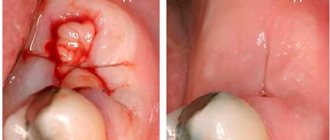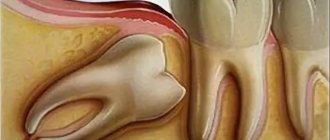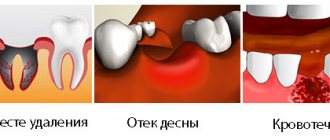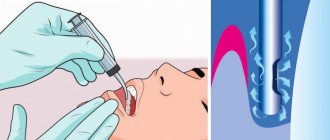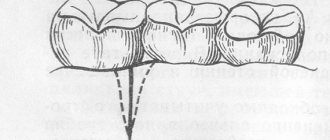The wisdom tooth is one of the most difficult teeth to treat and remove. The reasons lie in the unpredictability of this tooth, namely: the number of roots, canals, their shape, the tooth is often not fully erupted, covered with a mucous membrane, sometimes even with bone. Also, all manipulations with this tooth are complicated by its localization and very limited access. In addition, many patients experience problems with wide mouth opening.
All this makes the removal process very difficult and traumatic, so after removing a wisdom tooth, a swollen cheek and pain are normal, and you should not be afraid of them. To help your body cope with symptoms and speed up healing, you need to follow your doctor's orders and follow simple symptoms management tips.
Swelling after wisdom tooth removal: how long does it last?
How long does swelling last after wisdom tooth removal? This is the first question patients ask dentists. Swelling of the cheek after the extraction procedure is a reaction of the body. During the procedure of extracting a tooth, the doctor severely injures the soft tissues. This causes inflammation to develop. When the swelling subsides after wisdom tooth removal depends on the characteristics of each patient. It is of great importance which tooth was pulled out: on the upper or lower jaw.
The norm is slight swelling of the cheek, which persists for seven days. Extraction of the third molar is a micro-operation. Therefore, it is quite obvious that after it various side symptoms may appear. If the wisdom tooth was pulled out without the formation of flux, there will be no swelling in the cheek. When the anesthesia wears off, the patient may experience aching pain. In this case, the cheek swells a little. Even a slight increase in temperature is possible.
The norm is also a slight discharge of ichor from the wound. The next day, swelling may form and the gums begin to hurt. Special medications can relieve pain and inflammation. If the swelling lasts a week, but does not spread to the upper and lower jaw, this is not a reason to panic. Usually the swelling subsides on the third day. On the 4-5th day after extraction, the swelling will completely subside. In some patients, swelling of the gums after wisdom tooth removal finally subsides only after a week.
Not always a pathology
Most of us don't consider tooth extraction something out of the ordinary. Although we must not forget that this is still a surgical intervention. Naturally, the torn vessels and tissues will be swollen and painful, and this is absolutely normal. The more complex the intervention, the stronger these phenomena were. Even uncomplicated removal leads to normal tissue swelling. And since any swelling and pain are associated with stagnation and local deterioration of blood circulation, it is quite easy for inflammation to occur. The pain is especially severe after the effects of painkillers wear off. Normally, swelling and pain quickly disappear, and the hole heals.
Physiological local tissue swelling after tooth extraction is not a complication or threat to the patient’s health.
Swelling after wisdom tooth removal: causes
The causes of severe swelling after wisdom tooth removal are natural or pathological. Therefore, if suspicious signs are detected, you should visit the dentist. As we noted earlier, the appearance of swelling is a reaction of the body.
Edema occurs for the following reasons:
- The dental unit was removed due to inflammation. There could be an infection in the wound. It can aggravate gum swelling. To avoid the spread of inflammation to other tissues, the doctor treats the hole with antiseptics. For purulent inflammation, a course of antibacterial drugs is prescribed. You cannot take antibiotics on your own. Such drugs must be prescribed by a doctor.
- Difficult to remove. Often "eights" grow incorrectly. In such situations it is necessary to carry out operations. The doctor cuts and sutures the gum. As a result of such manipulations, the inflammatory process begins. Therefore, after microsurgery, the occurrence of edema is normal.
- The presence of concomitant diseases in the body. Many pathologies can provoke facial swelling. Swelling often occurs with hypertension.
- Inflammation of the gums before molar removal. In this case, the doctor has to make an incision in the gum to remove the purulent contents. Due to the accumulation of purulent masses, swelling forms on the patient’s cheek.
Facial swelling after wisdom tooth removal can be dangerous to your health. If swelling does not subside within a week, this is an alarming symptom. It is necessary to urgently contact the dentist. The doctor will competently diagnose and prescribe effective treatment. With complex therapy, the risk of complications will be minimized. According to patient reviews, swelling after wisdom tooth removal goes away quite quickly.
Treatment of a cyst under an extracted tooth
The neoplasm is treated surgically. An x-ray is taken first. The image shows the area where the capsule is localized, its size, complications, for example, bone melting after rupture of the bladder with advanced pathology.
The doctor removes the cystic sac, cleans the cavity of pus, if there is any, and carries out an antiseptic treatment. When using a laser, the operation is performed practically without blood, and wound healing is faster. In any case, you need to take antibiotics to prevent relapse.
When do you need dental help?
If severe swelling persists for a week, you should consult a doctor.
In what cases does this need to be done:
- The swelling does not go away within a week. Every day it increases in size. This sign indicates progressive inflammation. Swelling may spread to most of the face.
- The patient experiences severe pain and cannot eat or sleep.
- The formation of pus is noticeable in the hole. The pain is throbbing and intensifies in the evening.
- The body temperature rose and a fever began. There may be severe headaches.
- There was no swelling after the operation, but it appeared after 3-4 days. This condition also requires medical intervention. This may indicate the beginning of the development of alveolitis.
- A hematoma formed. Sometimes after extraction of figure eights, hematomas form. If the bruise is not accompanied by pain, you don't have to do anything. If there is a sharp throbbing pain, you need the help of a doctor.
Swelling after the removal of the lower wisdom tooth may go away on its own. But if it increases in size and is accompanied by acute pain, you should not delay a visit to the dentist. If an inflammatory process begins to develop, it will be problematic to remove it yourself. According to reviews from patients who encountered problems after pulling out eights, only a specialist can help in such situations.
What symptoms should you see a dentist for?
An abnormal condition can be considered if the swelling does not begin to subside on the 4th day after removal of the “sage”. Or if the swelling seemed to begin to go away, and then reappeared. You should also be alert if the cheek turns very red, becomes very hot, and any (even the lightest) touch to it results in unbearable pain.
The development of a pathological process can be assumed when the temperature rises to 39 degrees and above. Or if the pain does not subside 3 days after removal, if the gums have festered. And heavy bleeding 30 minutes after surgery is an urgent reason to seek medical help.
What complications may arise?
When swelling moves from the cheek to other parts of the face, other symptoms appear. All of them indicate the onset of the inflammatory process. How long does it take for swelling to go away after wisdom tooth removal? Usually the swelling lasts about a week.
What complications may arise after the procedure for removing figure eights:
- Dry hole. A serious pathology, which can be triggered by the washout or initial absence of a blood clot. After a tooth is removed, a blood clot should form in the socket. This is a kind of barrier that protects the wound from infection. If this clot is removed either involuntarily or intentionally, dry socket syndrome occurs. The wound does not heal for a long time. There is an unpleasant taste and smell in the mouth. In this case, only a dentist can effectively fix the problem. There is no way to speed up the healing process at home.
- Alveolitis. This is a dangerous complication, which is accompanied by the formation of pus in the socket. Mainly appears against the background of a “dry socket”. The disease most often occurs in the lower jaw after the removal of molars. Alveolitis may appear after extraction of dental units with cysts. The disease is characterized by swelling of all parts of the face. This condition is accompanied by an increase in body temperature. An unpleasant odor appears from the mouth. The patient feels weakness and aches.
- Osteomyelitis. A most serious pathology in which a purulent inflammatory process develops in bone tissue. According to patients, swelling on the cheek spreads very quickly. Swelling is accompanied by severe pain that covers the entire jaw. If a tooth has been removed from the lower jaw, the entire upper row of teeth may hurt. Talking with such a disease is very problematic. Patients may have difficulty opening their mouth. Osteomyelitis is characterized by high fever. According to patients, the disease is often accompanied by severe headaches. If you do not seek help in a timely manner, there is a risk of blood poisoning.
- Neuritis. Associated with damage to the facial nerve. Patients suffer from severe pain. Neuritis occurs more often when teeth with crooked roots are removed. The cheek, palate and tongue may become numb.
- Flux. Inflammation affecting the periosteum. Signs of flux: swelling of the cheek on the side of the extracted tooth.
- Abscess. The pathology affects the soft tissue of the gums. Severe pain covers the entire jaw.
Swelling after removal of an upper wisdom tooth does not always indicate the development of complications. Symptoms such as fever and severe pain should alert the patient. If the swelling does not go away on its own, you should immediately visit a doctor.
What to do if the gums are swollen, inflamed and painful, how to treat
To relieve swelling and pain, different methods are used, but in any case, a specialist should choose the appropriate method and means. What to do if your gums are inflamed and painful :
| Treatment of swelling and pain after tooth extraction | |
| Name | Description |
| Drug treatment | |
| Lymphomyosot, drops | The product improves lymph flow, kills germs, relieves inflammation, helps relieve swelling, and strengthens the body's protective functions. Oral drops, single dose – 10 drops. |
| Traumeel, tablets | A broad-spectrum drug: stops bleeding, relieves inflammation, pain, promotes cell regeneration. Take 1 tablet 3 times a day. |
| Suprastin, Claritin, tablets | The drugs are recommended for use for allergic manifestations. Daily dosage – 1 tablet 3 times a day. |
| Cholisal, gel | The gel has an anti-inflammatory, antimicrobial and analgesic effect, and gives quick results. Application of the product is carried out twice a day (morning and evening). |
| Metrodent, gel | Fold sterile gauze in four, apply a little gel to one side, apply to the tooth socket and hold for 10-15 minutes. |
| Analgin, Solpadein, Ketanol, tablets | Painkillers will help get rid of pain. The dose indicated in the instructions cannot be exceeded; if the drug is ineffective, it should be replaced with another drug. |
| Paracetamol | If your body temperature rises to 37.5°C or higher, you should take an antipyretic. |
| Traditional methods | |
| Applying cold | A cold compress inhibits the development of swelling. It should be applied in the first days after surgery for 15-20 minutes with a break of 1-2 hours. |
| Rinsing your mouth with decoctions | Some plants have anti-inflammatory and antiseptic effects. For example, chamomile, calendula, sage, oak bark. The duration of the procedure is 2 minutes, the treatment should be repeated every 1-2 hours. |
| Soda-salt rinses | A solution of salt and soda is excellent for inflammation. In addition, rinsing has an antiseptic effect. Solution recipe: a glass of warm water, tsp. soda, 0.5 tsp. salt. Repeat procedures 2-4 times a day. |
| Mouth rinses with Chlorhexidine or furatsilin | A solution of antiseptic agents is an effective agent with an antimicrobial effect. The movements of water in the mouth should not be too intense so as not to injure sensitive soft tissues. The holding time of the solution is at least 1 minute. |
Swelling after wisdom tooth removal: how to remove it
You can relieve swelling at home. But only on condition that it is provoked by natural processes. Normally, swelling lasts no more than 7 days. There should be no other signs of the inflammatory process.
You can relieve swelling at home using traditional medicine:
- Cold compresses. Apply a compress to your cheek. Ice wrapped in cloth will do. The procedure should not last longer than two minutes.
- A simple solution with salt will help relieve pain. To prepare the solution you will need two tsp. salt per glass of water at room temperature. A compress with this remedy will gradually relieve swelling.
- To make swelling go away faster, try to sleep on a high pillow. The outflow of excess fluid will increase. Therefore, the swelling goes away much faster.
How to get rid of swelling at home
If there is no reason to see a doctor, but you want to get rid of the swelling as soon as possible, you can try the following methods:
- Immediately after removal or surgery, apply a cold compress (water bottle, wet cloth). The application must be repeated throughout the day once every half hour for 5 minutes. ATTENTION! Using a cold compress on the second, third, etc. day is unacceptable.
- Use special decongestant ointments.
- Sleep with your pillow raised high.
- After a few days, cold compresses are replaced with warm ones. A single session of the procedure should not exceed half an hour. Vasodilation and increased blood flow promote faster recovery.
- use corticosteroids. Since this type of drug has many side effects, it is better to consult a doctor before taking it. You should resort to these medications only in cases of extreme necessity, when pain due to swelling interferes with normal daily activities.
- These methods should be used if there are no complications: in other cases, it is recommended to consult a doctor for a detailed examination.
Prevention measures
Swelling of the cheek after the extraction procedure can be avoided.
To do this, you should remember the following important recommendations:
- Mouth baths. Rinsing on the first day after tooth extraction is prohibited. Otherwise, there is a chance that the blood clot will be washed out of the socket. Special oral baths will reduce the risk of developing an inflammatory process.
- Anesthetics. Special medications will help relieve pain. In the first days after wisdom tooth removal, you can take medications. Next and Ibuprofen relieve pain well. Painkillers should be taken after consultation with the dentist.
- Try to eat healthy. On the first day after wisdom tooth extraction, you should not consume hot foods or drinks. Solid foods should also be avoided. Eat warm foods. You can only chew food on the opposite side.
- Don't forget about the rules of personal hygiene. Taking a hot bath is prohibited. This can lead to bleeding. You need to brush your teeth extremely carefully for the first three days so as not to damage the socket. You can rinse your mouth on the fourth day after the tooth extraction procedure. The use of antiseptic solutions is allowed.
- Drinking alcohol and smoking cigarettes is prohibited. This will have a detrimental effect on the body’s recovery after surgery.
How long does it take for swelling to subside after wisdom tooth removal? It all depends on the individual physiological characteristics of each patient. If the swelling does not go away on the seventh day after extraction, you should immediately consult a doctor. After diagnosis, the doctor will be able to provide treatment.
How to prevent complications?
To avoid swelling and subsequent treatment, it is recommended:
- Keep your head held high for at least 12 hours after surgery (or better yet, 24 hours). To do this, while lying down, you need to place several pillows under your head;
- do not touch the hole with your tongue or fingers;
- do not use warm compresses for 36 hours after surgery;
- do not smoke or drink alcohol for 72 hours after surgery.
Correct behavior after surgery is no less important than the procedure itself: if you adhere to the above rules, the swelling will go away either in the shortest possible time or will not occur at all.
In what cases is medical assistance needed?
Symptoms of the postoperative period should alert you in the following cases:
- with redness of the mucous membrane and skin, shortness of breath (signs of tachycardia);
- if a rash has formed on the upper body (allergy to drugs);
- when the tumor increases, it appears on other parts of the gum or on the entire side of the face;
- when your health worsens (fever, difficulty swallowing saliva, opening your mouth, painful chewing);
- progressive pain;
- if a putrid odor begins to emanate from the mouth;
- when the swelling went away after the operation, and after some time began to grow again;
- swelling lasts too long.
Each option may indicate an ongoing complication, so there is no point in wasting time postponing a visit to the doctor.
